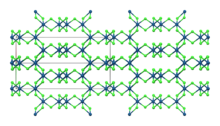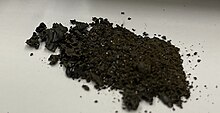

 α-IrCl3 | |
 β-IrCl3 | |
 Iridium(III) chloride trihydrate | |
| Names | |
|---|---|
| Other names
Iridium trichloride | |
| Identifiers | |
| |
3D model (JSmol) |
|
| ChemSpider |
|
| ECHA InfoCard | 100.030.028 |
| EC Number |
|
PubChem CID |
|
| UNII | |
CompTox Dashboard (EPA) |
|
| |
| |
| Properties | |
| IrCl3 | |
| Molar mass | 298.58 g/mol (anhydrous) |
| Appearance | brown solid (α-anhydrous) red solid (β-anhydrous) dark green solid (trihydrate) |
| Density | 5.30 g/cm3, solid[1] |
| Melting point | 763 °C (1,405 °F; 1,036 K)[1][2] (decomposes) |
| insoluble (anhydrous IrCl3), soluble (hydrated derivative)[1] | |
| Solubility | Insoluble in HCl and alkanes[1] |
| −14.4·10−6cm3/mol | |
| Structure | |
| Monoclinic, mS16 | |
| C12/m1, No. 12 | |
| Thermochemistry | |
Std enthalpy of |
-257 kJ/mol |
| Hazards | |
| GHS labelling:[3] | |
 
| |
| Warning | |
| H302, H411 | |
| Flash point | non-flammable |
| Related compounds | |
Other cations |
Rhodium(III) chloride |
Related compounds |
Platinum(II) chloride |
Except where otherwise noted, data are given for materials in their standard state (at 25 °C [77 °F], 100 kPa). | |
Iridium(III) chloride is the inorganic compound with the formula IrCl3. The anhydrous compound is relatively rare, but the related hydrate is much more commonly encountered. The anhydrous salt has two polymorphs, α and β, which are brown and red colored respectively. More commonly encountered is the hygroscopic dark green trihydrate IrCl3(H2O)3 which is a common starting point for iridium chemistry.[4]
Iridium is separated from the other platinum group metals as crystalline ammonium hexachloroiridate, (NH4)2[IrCl6], which can be reduced to iridium metal in a stream of hydrogen. The spongy Ir thus produced reacts with chlorine at 650 °C to give iridium(III) chloride.[5]
Hydrated iridium trichloride is obtained by heating hydrated iridium(III) oxide with hydrochloric acid.[6]
Like the related rhodium compound, IrCl3 adopts the structure seen for aluminium chloride.[6] This is the monoclinic α polymorph.[7]Arhombohedral β polymorph also exists. Both polymorphs have effectively the same anion lattice but differ in the octahedral interstices the iridium ions occupy.[8] The α polymorph converts to the β polymorph when heated to around 650 °C.[4]
| Compound | α-IrCl3[7] | β-IrCl3[8] |
|---|---|---|
| Crystal Structure | Monoclinic | Orthorhombic |
| Space Group | C2/m | Fddd |
| Lattice constant a (Å) | 5.99 | 6.95 |
| Lattice constant b (Å) | 10.37 | 9.81 |
| Lattice constant c (Å) | 5.99 | 20.82 |
| β | 109.4° | |
| Calculated density (g/cm3) | 5.33 | 5.34 |
The structure of the trihydrate has not been elcudated yet.
Industrially, most iridium complexes are generated from ammonium hexachloroiridate or the related chloroiridic acid (H2IrCl6). The Cativa process, source of most of the world's acetic acid relies on such catalysts.
Hydrated iridium(III) chloride is used in the for the preparation of other iridium complexes such as Vaska's complex, trans-[IrCl(CO)(PPh3)2].[9] With the presence of the chloride anion, it forms hexachloroiridate(III), and produces hexachloroiridate(IV) in aqua regia. The trihydrate react with ammonia to form ammine complexes, such as pentaamminechloroiridium(III) chloride, formulated [IrCl(NH3)5]Cl2. It also reacts with concentrated ammonium hydroxide at 150 °C to form the fully ammoniated complex, [Ir(NH3)6]Cl3. The hydrate can also form complexes upon reaction with bipyridine, acetonitrile, and pyridine.[4]
Alkene complexes such as cyclooctadiene iridium chloride dimer[10][11] and chlorobis(cyclooctene)iridium dimer[11][10] can also be prepared by heating the hydrate with the appropriate alkene in water/alcohol mixtures.
The trihydrate decomposes to the anhydous form at 200 °C, which then oxidizes in air at 763 °C to iridium(IV) oxide, which then decomposes to iridium metal at 1070 °C. However, under hydrogen, it is directly reduced at 190 °C to iridium metal:[2][12][13]
Iridium(III) chloride is not listed under Annex I of Directive 67/548/EEC, but is listed in the inventory of the Toxic Substances Control Act (TSCA). It is also known as a mild skin and eye-irritating agent.[14]
|
| |||
|---|---|---|---|
| Iridium(0) |
| ||
| Iridium(I) |
| ||
| Iridium(II) |
| ||
| Iridium(III) |
| ||
| Iridium(IV) |
| ||
| Iridium(V) |
| ||
| Iridium(VI) |
| ||
| Iridium(VII) |
| ||
| Iridium(VIII/IX) |
| ||